Mounted alpha-BBO UV Glan-Thompson Polarizer

- Designed for UV Laser Polarization Applications
- Polarization Extinction Ratio >100 000:1
- Laser Quality α-BBO Crystal Mounted in Ø1" Housing
- Single-Layer MgF2 Antireflection Coating Centered at 400 nm
GTHB10M
α-BBO Glan-Thompson Polarizer Mounted in Ø1" Housing
Application Idea
GTHB10M Polarizer Mounted in an SM1L10 Lens Tube and PRM1 Rotation Mount Assembly for Repeatable Polarization Control

Please Wait
| Item # | GTHB10M |
|---|---|
| Extinction Ratioa | >100 000:1 |
| Wavelength Range | 230 to 900 nm |
| Substrate | Laser Quality α-BBOb (Low Scatter) |
| Wavefront Distortion |
λ/4 at 633 nm |
| Beam Deviation | <3 arcmin |
| Surface Qualityc | 20-10 Scratch-Dig |
| Clear Aperture | >10.0 mm x 10.0 mm |
| Dimensions | Ø1.00" x 0.85" (Ø25.4 mm x 21.7 mm) |
Features
- High Extinction Ratio: >100 000:1
- 230 to 900 nm Operation
- Single-Layer AR (SLAR) MgF2 Coating Centered at 400 nm
- Clear Aperture >10.0 mm x 10.0 mm
- Fabricated from Laser-Quality α-BBO
- Glan-Thompson Design (Cemented Birefringent Crystal Prisms)
Thorlabs' Mounted α-BBO Glan-Thompson Polarizer is specifically designed to deal with short-wavelength laser light with transmission in the UV region while maintaining extremely high polarization purity (>100 000:1). The mounts consist of a black aluminum housing. The GTHB10M polarizer has a Ø1" outer diameter and can be conveniently held inside our Ø1" Lens Tubes. This allows the user to easily mount this polarizer to a rotation stage, such as the PRM1 Precision Rotation Mount for Ø1" optics. Please see the Mounting tab for more details.
This polarizer has a single-layer MgF2 antireflective coating (SLAR), centered at 400 nm. This coating also serves as a protective layer that prevents the hygroscopic α-BBO substrate from interacting with moisture in the environment. Please see the Graphs tab for coating reflectivity data. For alignment, it should be noted that the wide field of view of Glan-Thompson polarizers varies with the wavelength and entrance orientation of incident light; for more information on the field of view please see the Graphs tab.
This Glan-Thompson polarizer consists of two cemented prisms made from the laser-quality α-BBO. Unpolarized light enters the polarizer and is split at the interface between the two crystals. The ordinary rays are reflected at each interface, causing them to be scattered and partially absorbed by the polarizer housing. The extraordinary rays pass straight through the polarizer, providing a polarized output.
Note: As with all Glan-Thompson polarizers, the maximum optical intensity is limited by the cemented prism interface. For higher-power applications, Thorlabs offers a variety of Crystal Polarizers that can handle energy densities up to 20 J/cm2.
The typical transmission and reflectivity of an α-BBO Glan-Thompson polarizer is shown in the graphs below. The blue shading indicates the operating wavelength range 230 - 900 nm. The reflectivity plot represents the performance of the coating only, not including internal losses of the polarizer. The transmission plot includes both reflectivity and transmission through the polarizer (including any internal losses).

Click to Enlarge
Click Here for Raw Data
The reflection plot above shows the typical reflectivity of the MgF2 SLAR Coating on our GTHB10M Glan-Thompson α-BBO Polarizer, not including internal losses. While the specified operating range is 230 - 900 nm, the reflectivity remains low out to 2.0 µm.

Click to Enlarge
Click Here for Raw Data
The transmission plot above shows the typical transmission of a GTHB10M Glan-Thompson α-BBO Polarizer, including any internal losses. While the specified operating range is 230 - 900 nm, the transmission remains above 80% out to 2.0 µm. The transmission is valid for linearly polarized light aligned with the mark on the housing of the polarizer. The performance data shown above may vary from lot to lot and is not guaranteed.

Click to Enlarge
Click Here for Raw Data
The Fields of View (FOV) of the Glan-Thompson Polarizer are shown above. The side that absorbs the ordinary ray has an FOV that decreases as the wavelength increases (FOV 1). The opposite side has an FOV that increases as the wavelength increases (FOV 2).
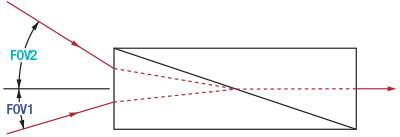
Glan-Thompson Polarizers feature a field of view (FOV) that varies with both wavelength and entrance orientation. The FOV of the internal prisms must be considered during alignment and collimation procedures. The side that absorbs the ordinary ray has an FOV that decreases as the wavelength increases (FOV 1). The opposite side has an FOV that increases as the wavelength increases (FOV 2). The FOV of Glan-Thompson polarizers is typically greater than the FOV of Glan-Taylor polarizers.
Polarization-Dependent Refraction
Glan-Thompson α-BBO Polarizer
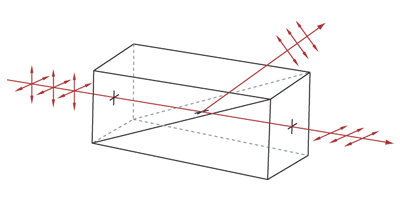
General
Thorlabs' α-BBO polarizers are all based on high-grade, birefringent α-BBO crystals. Due to the birefringent nature of α-BBO, waves polarized in the direction of the optical axis propagate with a different index of refraction than waves polarized orthogonally to the optical axis. In our Glan-Thompson polarizers, this birefringence causes the ordinary polarization component of an incident beam to undergo total internal reflection at an internal crystal-to-epoxy interface. The light transmitted through the polarizer then consists of only the remaining extraordinary polarization component. While these transmitted extraordinary rays are highly polarized, the reflected ordinary rays are only partially polarized.
Our Glan-Thompson, Glan-Laser, and Glan-Taylor polarizers are designed as polarizer elements that remove the reflected ordinary polarization component of a beam. These polarizers are built out of two prisms, as shown in the drawing to the right. They are only designed to work with well collimated light beams; converging and diverging input beams may not exhibit proper polarization and incidence angle at the internal interface. Since α-BBO is a soft crystal that is easily damaged, all of our α-BBO polarizers are offered in metal housings. With convenient threadings and adapters, these housings can easily be mounted into our opto-mechanical products.
Field of View
α-BBO polarizers feature a field of view (FOV) that varies with both wavelength and entrance orientation. The FOV of these prisms must be considered during alignment and collimation procedures. One side of the polarizer has an FOV that decreases with increasing wavelength (FOV 1), while the opposite side has an FOV that increases at longer wavelengths (FOV 2).
Field of View Angle Orientation

Transmission
Thorlabs uses only the highest quality synthetic α-BBO in our polarizing prisms. The transmission curve of the α-BBO polarizer is shown on the Graphs tab. Variations during the manufacturing of the α-BBO crystal can affect the transmission curve.
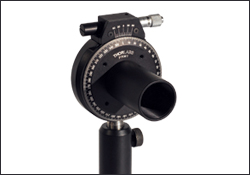
Figure 2
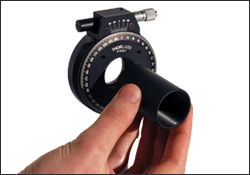
Figure 1
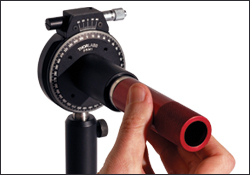
Figure 4
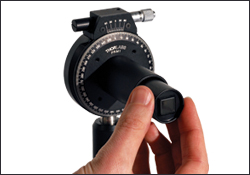
Figure 3
Mounting the GTHB10M
The GTHB10M polarizer can be mounted to a PRM1 rotation mount by using one of our Ø1" Lens Tubes:
- Remove the retaining rings that come with the PRM1 rotation mount and the lens tube.
- Screw the threaded end of the lens tube into the rotation mount as shown in Figure 1.
- Once the lens tube is threaded (Figure 2), insert the mounted polarizer into the other end of the lens tube (see Figure 3)
- Secure the polarizer into place using the retaining ring included with the lens tube.
- An SPW602 spanner wrench can be used to tighten the retaining ring (Figure 4).
Note: The SM1P1 Ø1" to SM1 adapter can be used in place of the lens tube when space is not available for the extra length of the lens tube.
Polarizer Selection Guide
Thorlabs offers a diverse range of polarizers, including wire grid, film, calcite, alpha-BBO, rutile, and beamsplitting polarizers. Collectively, our line of wire grid polarizers offers coverage from the visible range to the beginning of the Far-IR range. Our nanoparticle linear film polarizers provide extinction ratios as high as 100 000:1. Alternatively, our other film polarizers offer an affordable solution for polarizing light from the visible to the Near-IR. Next, our beamsplitting polarizers allow for use of the reflected beam, as well as the more completely polarized transmitted beam. Finally, our alpha-BBO (UV), calcite (visible to Near-IR), rutile (Near-IR to Mid-IR), and yttrium orthovanadate (YVO4) (Near-IR to Mid-IR) polarizers each offer an exceptional extinction ratio of 100 000:1 within their respective wavelength ranges.
To explore the available types, wavelength ranges, extinction ratios, transmission, and available sizes for each polarizer category, click More [+] in the appropriate row below.
| Wire Grid Polarizers |
|---|
| Film Polarizers |
|---|
| Beamsplitting Polarizers |
|---|
| alpha-BBO Polarizers |
|---|
| Calcite Polarizers |
|---|
| Quartz Polarizers |
|---|
| Magnesium Fluoride Polarizers |
|---|
| Yttrium Orthovanadate (YVO4) Polarizers |
|---|
| Rutile Polarizers |
|---|
| Posted Comments: | |
| No Comments Posted |
 Products Home
Products Home









 Glan-Thompson α-BBO Polarizer, Mounted
Glan-Thompson α-BBO Polarizer, Mounted